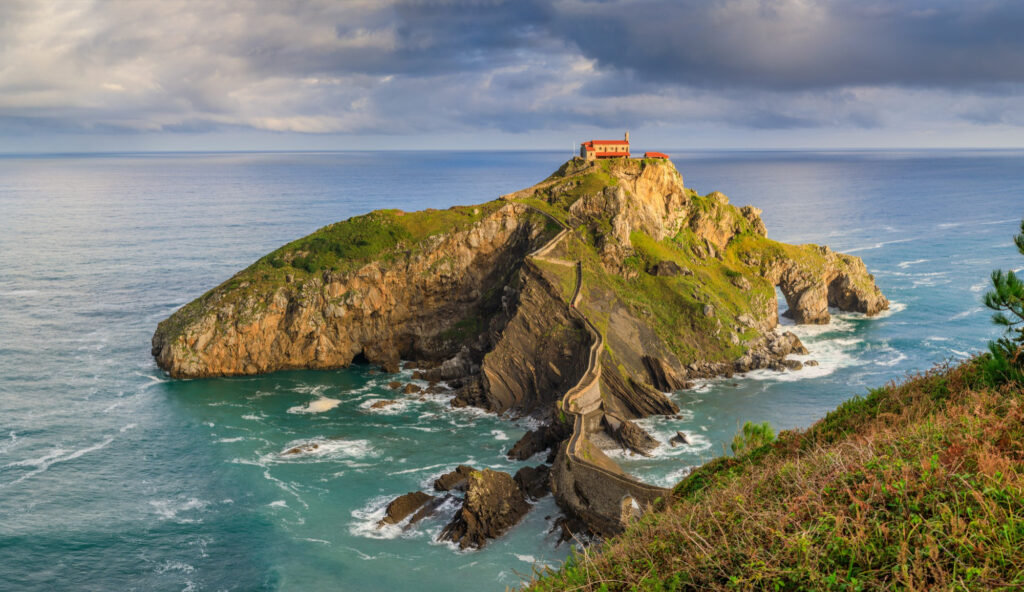Portugal, a country known for its rich history, diverse landscapes, and warm hospitality, is a treasure trove of travel experiences waiting to be discovered. Located on the western edge of the Iberian Peninsula, Portugal offers an intriguing blend of old-world charm and vibrant modernity. From the bustling cities of Lisbon and Porto, the idyllic beaches of the Algarve, to the enchanting palaces of Sintra, and the untouched natural beauty of the Azores, there’s an array of captivating sights to explore.
In this article, we’ll guide you through the ten most beautiful places in Portugal that should be on every traveler’s bucket list. Whether you’re an avid history buff, a nature enthusiast, a food lover, or simply someone seeking a unique travel experience, Portugal’s charm is bound to captivate you. Get ready to embark on a journey through Portugal’s most stunning landscapes, vibrant cities, and quaint villages, each offering a unique blend of culture, history, and natural beauty.
As we delve into the heart of Portugal, we’ll uncover centuries-old monuments, picturesque vineyards, sun-soaked beaches, and verdant mountains. Along the way, we’ll also get a taste of Portugal’s rich gastronomy, from the delectable pastries of Lisbon to the world-renowned Port wine of Porto.
Each destination in Portugal is unique in its own right. In Lisbon, the capital city, you’ll find an intriguing mix of traditional architecture and cutting-edge design, with ancient ruins standing alongside vibrant modern structures. Porto, the country’s second city, oozes with history and culture, from its UNESCO-listed historic center to its iconic wine cellars.
The beautiful town of Sintra, once a favorite of Portuguese royalty, will transport you to a world of fairy-tale palaces and mystical forests. Down south, the Algarve region beckons with its stunning coastline, dotted with golden sandy beaches and dramatic cliffs.
If you’re seeking solace in nature, the island of Madeira and the Azores archipelago offer untamed landscapes, from towering mountains to deep sea waters teeming with marine life. The cities of Coimbra and Evora, steeped in academic traditions and ancient history respectively, will give you a deeper understanding of Portugal’s past.
We will also explore the Douro Valley, the birthplace of Port wine, with its terraced vineyards providing an unforgettable scenic view. Lastly, we’ll step back in time in Obidos, a charming medieval town encased within ancient walls.
So, pack your bags and prepare your senses for an unforgettable journey through Portugal’s most beautiful destinations. Whether you’re strolling through the vibrant streets of its cities, hiking through lush island trails, or simply soaking up the sun on a sandy beach, Portugal promises a travel experience like no other. Let’s embark on this journey and uncover the diverse beauty that Portugal holds.
Exploring Lisbon: Discovering the Vibrant Capital of Portugal
Lisbon, the vibrant capital of Portugal, is a city that effortlessly blends traditional heritage with striking modernism and progressive thinking. As one of the oldest cities in Western Europe, Lisbon offers a rich tapestry of historical architecture, vibrant street life, and a thriving cultural scene.
Overview of Lisbon
Set against the ever-present backdrop of the Atlantic Ocean, Lisbon is a city of seven hills, each offering a unique vantage point over the city’s pastel-colored buildings and the shimmering waters beyond. Known for its warm and sunny disposition both in terms of climate and people, Lisbon is a city that invites exploration.
Key Attractions in Lisbon
One of the must-see sights in Lisbon is the historic Belem Tower (Torre de Belém), a UNESCO World Heritage site that once guarded the city’s harbor and now symbolizes Portugal’s Age of Discoveries. Nearby, you’ll find the Jeronimos Monastery, another UNESCO site, and a masterpiece of Manueline architecture.
The Alfama district, the oldest in Lisbon, is a maze of narrow streets, ancient houses, and traditional Fado music bars. Ride the historic Tram 28 to navigate these winding streets and soak up the atmosphere of old Lisbon. Don’t forget to visit the city’s cathedral, Sé de Lisboa, and the commanding São Jorge Castle, both nestled within Alfama.
Culture and Cuisine of Lisbon
Lisbon is also famed for its lively culture. From the melancholic tunes of Fado that echo in the streets, to the vibrant nightlife in the Bairro Alto district, the city is alive with music and movement. Lisbon’s gastronomy is also a highlight, with a plethora of restaurants serving everything from traditional Portuguese dishes to innovative contemporary cuisine. Try the iconic pastel de nata (custard tart), fresh seafood, or the local ginjinha cherry liqueur.
Whether you’re a history buff, a foodie, or a culture lover, Lisbon offers an enticing array of experiences. With its friendly locals, rich history, and an unbeatable riverside location, it’s no wonder that Lisbon is often considered one of the most beautiful places to visit in Portugal.
Unveiling Porto: A Journey Through History, Culture, and Port Wine
Porto, Portugal’s second-largest city, is a captivating place known for its stately bridges, historic architecture, and of course, its world-famous port wine. Nestled along the hills overlooking the Douro River, Porto is a city rich in history and character.
Introduction to Porto
Porto’s history stretches back centuries, and its landscape is a testament to its rich past. The city’s Ribeira district, with its narrow cobbled streets, colorfully tiled buildings, and ancient monuments, has been designated a UNESCO World Heritage site. Yet, Porto is not just about the past; it’s a vibrant, living city with a thriving cultural scene and a buzzing nightlife.
Iconic Sites in Porto
One of Porto’s most iconic sites is the Dom Luís I Bridge, a double-deck iron bridge that spans the Douro River, offering panoramic views of the city and the river below. You should also visit the Ribeira District, a picturesque neighborhood filled with medieval streets, local taverns, and small squares teeming with life.
No visit to Porto would be complete without exploring its famous wine cellars. Located across the river in Vila Nova de Gaia, these cellars offer tours and tastings of the city’s namesake Port wine. The Church of São Francisco and Palacio da Bolsa are also worth a visit for their historical and architectural value.
Porto’s Traditions and Gastronomy
Porto is also a city of traditions. From the high-spirited celebrations of the São João Festival to the centuries-old tradition of producing Port wine, the city has a unique cultural identity. Porto’s cuisine is another highlight, known for its hearty and flavorsome dishes like the Francesinha sandwich and Bacalhau à Brás (codfish dish). Coupled with a glass of Douro Valley wine or a Port, it’s a gastronomic experience not to be missed.
With its distinctive character, inviting charm, and a rich array of experiences, Porto is a destination that promises to delight every traveler. Its vibrant history, delicious cuisine, and the warm hospitality of its people make Porto one of the most beautiful and memorable places to visit in Portugal.
Sintra: Portugal’s Fairy-Tale Town of Palaces and Enchanting Landscapes
Sintra, a picturesque town located just outside Lisbon, is like stepping into a fairy tale. Its stunning palaces, lush gardens, and enchanting forests have earned it a place as a UNESCO World Heritage site and made it one of Portugal’s most popular destinations.
Overview of Sintra
Nestled in the foothills of the Sintra Mountains, the town of Sintra has long been a favorite retreat for Portuguese royalty and nobility, and it’s easy to see why. Its cooler climate, verdant landscapes, and the presence of numerous palaces and estates make it a place of beauty and grandeur.
Sintra’s Palaces and Natural Beauty
The crown jewel of Sintra is the Pena Palace, a Romanticist castle that stands atop a hill in the Sintra Mountains. Painted in vivid hues of yellow and red, and surrounded by a large park, the palace is one of Portugal’s most visited monuments.
Another unmissable sight is the Quinta da Regaleira, a complex that includes a Gothic palace, lush gardens, and an intriguing initiation well. Other notable palaces include the Moorish Castle and the National Palace of Sintra.
Aside from palaces, Sintra is also known for its natural beauty. The Sintra-Cascais Natural Park is a vast expanse of diverse landscapes, from sand dunes and forests to dramatic cliffs and pristine beaches.
Sintra’s Rich History and Culture
Sintra’s rich history is evident in its architecture, from the medieval streets of the old town to the grand estates that dot the landscape. The town’s culture is deeply intertwined with its history, with many local traditions related to its past as a royal sanctuary.
Sintra’s culinary scene is also worth exploring. Don’t miss the chance to try local specialties like queijadas de Sintra (a traditional sweet pastry) and travesseiros (almond pastries).
With its enchanting blend of natural beauty and architectural wonders, Sintra is a must-visit destination in Portugal. Its fairy-tale-like ambiance, rich history, and unique cultural experiences make it one of the most beautiful places in the country.
Uncovering the Algarve: Portugal’s Paradise of Sun-Kissed Beaches and Charming Towns
The Algarve, located in the southernmost region of Portugal, is known for its idyllic beaches, charming fishing towns, and lush golf resorts. With its Mediterranean climate, the Algarve offers a year-round appeal for travelers in search of sun, sea, and sand.
Introduction to The Algarve
The Algarve is Portugal’s most popular tourist destination, and it’s easy to see why. With its sunny weather, beautiful landscapes, and friendly locals, the region offers a relaxed and inviting atmosphere. The coastline, stretching over 150 km, is diverse and dramatic, with cliffs overlooking golden sandy beaches and crystal-clear waters.
Highlights of The Algarve
The towns of Faro, Lagos, and Albufeira are some of the top places to visit in the Algarve. Faro, the region’s capital, is known for its historic old town and lively cultural scene. Lagos offers beautiful beaches and a vibrant nightlife, while Albufeira is famed for its old town filled with local shops, restaurants, and bars.
The Algarve is also home to some of Portugal’s most beautiful beaches, like Praia da Marinha and Praia da Falésia. For nature lovers, the Ria Formosa Natural Park is a must-visit, with its unique lagoon system and diverse wildlife.
Outdoor Activities and Experiences in The Algarve
The Algarve is a haven for outdoor activities. Whether it’s playing golf on one of the region’s many top-rated courses, surfing the waves on the western coast, or exploring the region’s beautiful landscapes on a hiking or cycling trail, there’s something for everyone.
The region’s gastronomy is another highlight, with a focus on fresh seafood, local wines, and delicious pastries. Try the traditional cataplana (seafood stew) or the local pastel de nata.
With its stunning landscapes, relaxed lifestyle, and a wide range of experiences, the Algarve is a destination that invites you to unwind and immerse yourself in its natural beauty. Its charm, warmth, and diversity make it one of the most beautiful places to visit in Portugal.
Madeira: Unveiling the ‘Pearl of the Atlantic’ and Its Natural Wonders
Madeira, an archipelago situated in the North Atlantic Ocean, is one of Portugal’s most enchanting destinations. Known as the ‘Pearl of the Atlantic,’ Madeira offers a unique blend of stunning natural beauty, vibrant culture, and a year-round mild climate.
Introduction to Madeira
Madeira is composed of four islands, with the main island of Madeira being the most populous and developed. The islands are known for their dramatic landscapes, which include rugged mountains, lush forests, and beautiful coastline. Madeira’s location and volcanic origin have created a unique environment that is a paradise for nature and outdoor enthusiasts.
Natural Wonders and Attractions in Madeira
One of Madeira’s most iconic natural attractions is its Laurisilva forest, a UNESCO World Heritage site that covers a significant portion of the island. The forest is filled with unique plant and animal species and is crisscrossed by levadas, or irrigation channels, which double as hiking trails.
The island’s capital, Funchal, offers a blend of natural beauty, historic sites, and vibrant culture. Key sights include the colorful Mercado dos Lavradores (Farmers’ Market), the beautiful Monte Palace Tropical Garden, and the Funchal Cathedral.
Madeira is also known for its stunning coastline and natural swimming pools, like those at Porto Moniz. These pools, formed by volcanic lava, are filled with crystal-clear ocean water and are a popular spot for swimming and sunbathing.
Madeira’s Culture and Gastronomy
Madeira has a rich culture, influenced by Portuguese traditions but also unique to the island. The annual Carnival and Flower Festival are vibrant displays of this culture, with colorful parades, traditional music, and dance.
Madeira’s gastronomy is renowned, particularly its namesake wine. Other local specialties include ‘espada com banana’ (scabbard fish with banana), ‘bolo do caco’ (a traditional bread), and ‘poncha’ (a local alcoholic beverage).
With its breathtaking natural beauty, rich culture, and warm hospitality, Madeira offers an unforgettable Portuguese island experience. Its diverse landscapes and unique attractions make it one of the most beautiful places to visit in Portugal.
Exploring the Azores: A Dive into Portugal’s Volcanic Islands and Natural Splendor
The Azores, an archipelago located in the middle of the Atlantic Ocean, is one of Portugal’s most unique and captivating destinations. Known for their lush landscapes, rich biodiversity, and vibrant culture, these nine volcanic islands offer a paradise for nature lovers and adventurers.
Introduction to The Azores
The Azores are divided into three groups: the Eastern Group (São Miguel and Santa Maria), the Central Group (Terceira, Graciosa, São Jorge, Pico, and Faial), and the Western Group (Flores and Corvo). Each island has its own distinctive character and charm, but all share a common allure: a stunning natural environment where life moves at a slower, more peaceful pace.
Natural Beauty and Landmarks in The Azores
The Azores are a haven for outdoor activities and nature tourism. The islands offer excellent opportunities for hiking, whale watching, diving, and bird watching. The dramatic landscapes include everything from azure crater lakes, such as the twin lakes of Sete Cidades in São Miguel, to the highest peak in Portugal on Pico Island.
The islands are also home to UNESCO Biosphere Reserves, highlighting their significant ecological and biodiversity value. Furnas, on São Miguel Island, is renowned for its hot springs and geysers, while the vineyards of Pico, a UNESCO World Heritage site, display a unique viticulture practice.
Culture and Gastronomy of The Azores
The culture of the Azores reflects the islands’ history and isolation, with a strong sense of community and tradition. Notable cultural landmarks include the historic city center of Angra do Heroísmo on Terceira Island, another UNESCO World Heritage site.
Azorean gastronomy is deeply influenced by the islands’ volcanic nature and maritime location. Fresh seafood is abundant, with local dishes often featuring tuna, octopus, and limpets. Also notable is the Azorean pineapple, grown in unique greenhouses, and the local Azorean tea, the only tea plantation in Europe.
From their breathtaking landscapes to their rich marine life and cultural traditions, the Azores offer a unique and immersive travel experience. Their remote location and untouched beauty make them one of the most beautiful and intriguing places to visit in Portugal.
Coimbra: A Journey Through Portugal’s Historic City of Knowledge and Culture
Coimbra, a riverfront city in central Portugal, is steeped in history and culture. Famous for its historic university and vibrant student life, Coimbra offers a blend of old-world charm and youthful energy that makes it one of the country’s most unique destinations.
Introduction to Coimbra
Coimbra was once the medieval capital of Portugal, and the city’s rich history is evident in its architecture and cultural landmarks. At its heart stands the University of Coimbra, one of the oldest continuously operating universities in the world, which has shaped the city’s identity and earned it a place as a UNESCO World Heritage site.
Historical and Cultural Attractions in Coimbra
The University of Coimbra is the city’s most iconic site. Its grand buildings and beautiful courtyards are a testament to the importance of learning and knowledge in Coimbra’s history. The highlight is the Joanina Library, a Baroque masterpiece known for its ornate decor and priceless collection of ancient books.
Beyond the university, Coimbra has much to offer. The Old Cathedral (Sé Velha) is a well-preserved example of Romanesque architecture, while the Monastery of Santa Cruz houses the tombs of Portugal’s first two kings. The Machado de Castro National Museum, located on the site of a former Roman forum, has a rich collection of art and artifacts.
Coimbra’s Atmosphere and Traditions
Coimbra’s vibrant atmosphere is largely shaped by its student population. Traditional student songs, known as ‘fado de Coimbra’, can be heard in the streets and taverns, and the annual Queima das Fitas (Burning of the Ribbons) festival is a lively celebration of student life.
Coimbra’s gastronomy is also worth exploring, with local specialties including “chanfana” (goat stew), “leitão da Bairrada” (roast suckling pig), and “pasteis de Tentúgal” (sweet egg pastries).
With its blend of historical grandeur, academic tradition, and youthful energy, Coimbra is a city that invites exploration and discovery. Its unique charm and cultural richness make it one of the most beautiful and intriguing places to visit in Portugal.
Evora: Unraveling Portugal’s Rich History in Its Museum-City
Evora, located in the heart of the Alentejo region, is a treasure trove of Portuguese history and culture. Known as the ‘Museum City’, Evora’s well-preserved cityscape is a testament to the various cultures that have influenced it over the centuries, earning it a place as a UNESCO World Heritage site.
Introduction to Evora
Evora’s history dates back over 2,000 years, and its diverse architectural styles reflect the Roman, Moorish, Gothic, and Manueline periods. The city is known for its whitewashed houses, ornate churches, and the iconic Roman Temple, which together create a picturesque and historic cityscape.
Historical and Architectural Landmarks in Evora
The Roman Temple, also known as the Temple of Diana, is perhaps Evora’s most recognizable landmark. Despite being over 2,000 years old, its Corinthian columns still stand proudly in the city center.
Another significant site is the Cathedral of Evora, a massive structure that blends Romanesque and Gothic architectural styles. Its rooftop offers panoramic views of the city and surrounding countryside.
Evora’s Chapel of Bones, part of the Royal Church of St. Francis, is a unique attraction. The interior walls are lined with the bones and skulls of thousands of people, providing a stark memento mori.
Culture and Gastronomy of Evora
Evora’s rich history extends to its cultural traditions and gastronomy. The city is known for its production of cork, ceramics, and local Alentejo wines. Traditional music and dance, such as the “cante alentejano,” a form of polyphonic singing, add to the city’s cultural richness.
The cuisine of Evora reflects the Alentejo region’s agricultural abundance. Local specialties include “açorda Alentejana” (a bread soup), “migas” (fried bread crumbs with various ingredients), and “queijo de Serpa” (a local cheese).
Evora’s blend of historical landmarks, cultural traditions, and regional gastronomy provides a rich and immersive travel experience. Its well-preserved cityscape and historical depth make it one of the most beautiful and intriguing places to visit in Portugal.
Savoring the Douro Valley: Portugal’s Majestic Landscape of Vines and Wines
The Douro Valley, located in the northern part of Portugal, is one of the country’s most spectacular and vibrant regions. As the world’s first demarcated wine region and a UNESCO World Heritage site, the Douro Valley is renowned for its scenic beauty, historic quintas (wine estates), and, of course, its world-class wines.
Introduction to the Douro Valley
Stretching along the Douro River, this region is characterized by steep terraced vineyards that ripple across the landscape. The Douro Valley’s unique geographical conditions and climate make it an ideal location for wine production, notably for its famous Port wine.
Wine Tourism and Landmarks in the Douro Valley
The Douro Valley is a dream destination for wine lovers. A visit to one of the region’s quintas offers a chance to explore historic wine estates, learn about the winemaking process, and sample some of the best wines Portugal has to offer. Quinta do Crasto, Quinta da Pacheca, and Quinta de La Rosa are just a few of the estates that welcome visitors.
The region’s scenic beauty can also be enjoyed through a river cruise on the Douro or a train journey along the river’s edge, offering stunning views of the vineyard-covered hillsides.
Local Culture and Gastronomy of the Douro Valley
The culture of the Douro Valley is deeply tied to its wine production, with traditions and festivals centered around the annual grape harvest. The local cuisine is hearty and robust, often accompanied by the region’s excellent wines. Dishes to try include “bacalhau à Gomes de Sá” (codfish with potatoes and onions) and “posta à Mirandesa” (a local steak dish).
The Douro Valley’s combination of stunning landscapes, rich wine heritage, and local cultural traditions make it an unforgettable destination. Its unique charm and beauty firmly establish it as one of the most beautiful places to visit in Portugal.
Obidos: Stepping Back in Time in Portugal’s Charming Medieval Town
Obidos is a picturesque town located in the Leiria district of Portugal. Known for its well-preserved medieval architecture, Obidos’ charming cobblestone streets, vibrant whitewashed houses with colorful trim, and imposing castle make it an enchanting place to visit.
Introduction to Obidos
Encircled by an ancient fortified wall, Obidos takes visitors on a journey back in time. Its historic center is a labyrinth of narrow, winding streets filled with traditional houses, while its castle stands as a prominent reminder of the town’s medieval past.
Historical and Cultural Attractions in Obidos
The Obidos Castle, now a luxurious hotel, is one of the town’s main attractions. Visitors can also walk along the town’s fortified walls, providing excellent views over the rooftops and the surrounding countryside.
Churches such as Santa Maria, with its blue and white azulejos (tiles), and São Pedro add to the historic ambiance of the town. The town also houses a number of charming bookstores, including one located in a centuries-old church, reflecting Obidos’ status as a UNESCO City of Literature.
Events and Gastronomy in Obidos
Obidos is known for its vibrant events, most notably the annual Medieval Market, when the town comes alive with medieval music, jousting knights, and vendors selling handicrafts and traditional foods. The town also hosts an International Chocolate Festival, where the streets are filled with stalls selling a variety of chocolate treats.
The local gastronomy is a delight to explore, with specialties like “ginjinha,” a cherry liqueur often served in chocolate cups, and “caldeirada de peixe,” a flavorful fish stew.
With its rich history, cultural events, and delightful cuisine, Obidos offers visitors an immersive experience of medieval charm combined with local traditions. Its preserved beauty and enchanting atmosphere make it one of the most attractive places to visit in Portugal.









